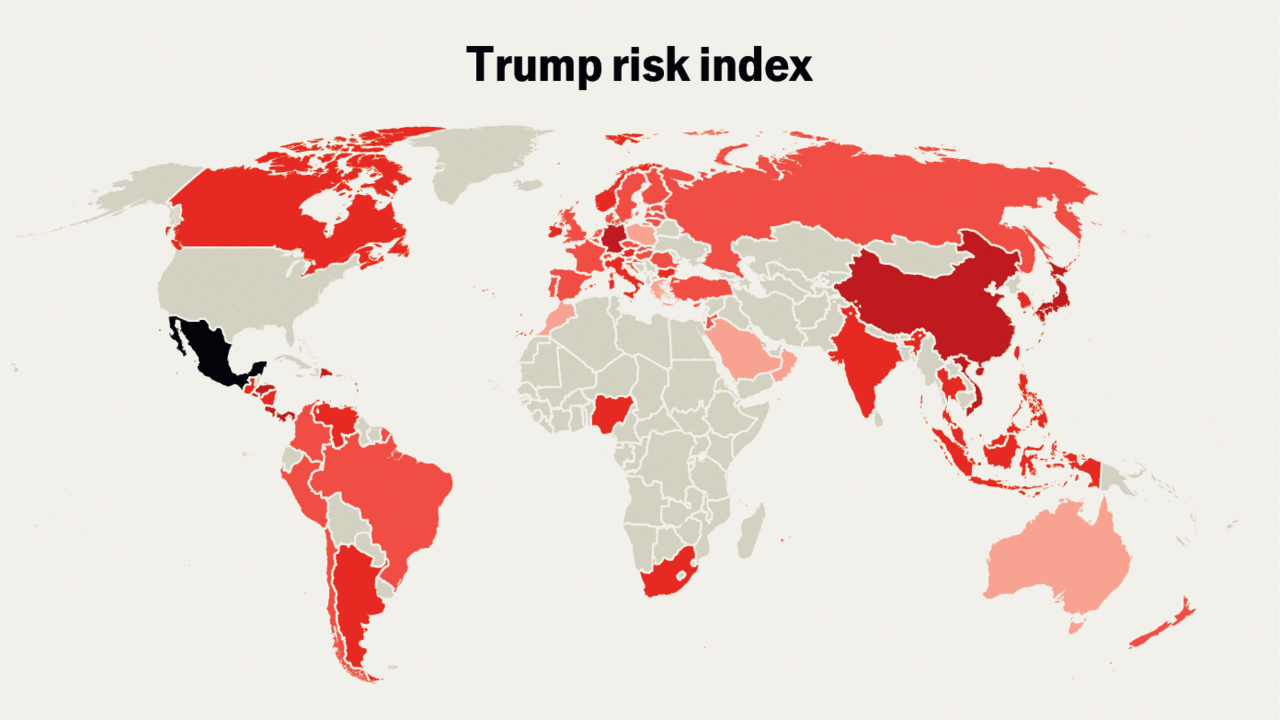The Impact Of Trump's Budget Cuts On Tornado Preparedness And Response

Table of Contents
Reduced Funding for the National Weather Service (NWS)
Trump's administration implemented budget cuts that significantly impacted the National Weather Service's ability to effectively warn and protect communities from tornadoes. This diminished capacity translates directly into increased risk.
Impact on Forecasting Accuracy
Budget cuts directly hampered the NWS's ability to maintain and upgrade its critical forecasting infrastructure. This resulted in less accurate and timely tornado warnings, increasing the danger to the public.
- Fewer Doppler radar systems: Outdated or insufficient radar systems limit the NWS's capacity to detect and track tornadoes accurately, leading to delayed or inaccurate warnings.
- Reduced staffing for weather prediction models: Fewer meteorologists and technicians mean less capacity to analyze complex weather data and refine predictive models, reducing warning accuracy.
- Limitations on research and development: Budget constraints limit the development of new and improved forecasting technologies, hindering advancements in tornado prediction.
The consequences are clear: delayed or inaccurate warnings leave communities vulnerable, increasing the risk of fatalities and significant property damage. The cost of this inaccuracy is measured not only in dollars, but also in human lives.
Impact on Storm Chasing and Data Collection
Reduced funding also affected vital storm chasing programs and research initiatives that are crucial for improving our understanding of tornado formation and behavior.
- Fewer researchers in the field: Limited funding means fewer scientists are able to collect vital real-time data during tornado events, hindering advancements in forecasting models.
- Less advanced technology for data acquisition: Restrictions on funding for cutting-edge data collection technologies reduces the quality and quantity of data available for analysis.
- Reduced understanding of tornado formation and behavior: A lack of research hampers our ability to predict tornado intensity and path, limiting the effectiveness of early warning systems.
This lack of investment in research directly translates to less accurate future warnings, increasing the vulnerability of communities to future tornado outbreaks.
Decreased Funding for FEMA and Disaster Relief
Budget cuts also severely impacted the Federal Emergency Management Agency (FEMA), the federal agency responsible for coordinating disaster relief efforts after a tornado. This resulted in slower response times and reduced resources for affected communities.
Slower Response Times and Resource Allocation
Limited funding directly impacts FEMA's capacity to respond effectively to tornado disasters.
- Reduced personnel for emergency response: Fewer personnel limits the agency's ability to deploy resources quickly and efficiently to affected areas.
- Limited funds for temporary housing: Reduced funding restricts the availability of temporary housing for displaced individuals and families, prolonging their suffering.
- Less available aid for infrastructure repairs: Budget constraints limit the amount of federal assistance available for repairing damaged infrastructure, slowing down the recovery process.
The consequences include prolonged suffering for affected communities, a slower recovery process, and increased long-term economic damage. The immediate aftermath of a tornado is already a crisis; budget cuts only exacerbate this hardship.
Impact on Community Preparedness Programs
Funding cuts extended to community-based preparedness programs, significantly reducing educational initiatives and disaster drills.
- Fewer public awareness campaigns: Less funding for public education campaigns means fewer communities are informed about tornado safety and preparedness measures.
- Limited resources for community shelters: Reduced funding restricts the resources available for building and maintaining safe community shelters.
- Reduced training for emergency responders at the local level: Fewer resources translate to less training for local first responders, impacting their ability to effectively react during a tornado.
These shortcomings result in less informed communities, increased vulnerability during tornado events, and a less effective community response, compounding the dangers of these devastating storms.
The Long-Term Effects of Budget Cuts on Tornado Resilience
The consequences of Trump's budget cuts extend far beyond the immediate aftermath of a tornado. These cuts contribute to a dangerous cycle of increased vulnerability and long-term economic losses.
Increased Vulnerability and Economic Losses
Reduced preparedness and response capabilities lead to significant long-term consequences.
- Higher insurance premiums: Increased losses due to inadequate preparedness and response force insurance companies to raise premiums for residents in high-risk areas.
- Slower economic recovery: Limited resources hinder economic recovery in affected areas, leaving communities struggling for extended periods.
- Increased societal burden on taxpayers: The cost of rebuilding and recovering from under-prepared disasters is ultimately shouldered by taxpayers.
This creates a dangerous cycle: under-preparedness leads to greater damage, which leads to higher costs and, in turn, further reductions in preparedness funding.
The Political and Social Implications
Inadequate funding for tornado preparedness carries substantial political and social consequences.
- Increased pressure on existing resources: Existing resources are stretched thin, leading to a strained system unable to cope with the demands of a major tornado event.
- Potential for political gridlock on disaster relief: Disagreements on disaster relief funding can lead to political gridlock, delaying or preventing crucial aid from reaching affected communities.
- Highlighting inequalities in disaster response: Budget cuts disproportionately impact communities with fewer resources, highlighting existing social and economic inequalities.
These issues create a pressing need for greater awareness and action to address the shortcomings in national disaster preparedness initiatives.
The Urgent Need for Increased Investment in Tornado Preparedness and Response
In conclusion, Trump's budget cuts have significantly weakened the nation's ability to prepare for and respond to tornadoes. The resulting increase in vulnerability to these devastating storms is unacceptable. Reduced funding for the NWS has led to less accurate forecasting, while cuts to FEMA have hampered disaster relief efforts. Community preparedness programs have also suffered, leaving communities ill-equipped to handle tornado events. The long-term consequences of these cuts include increased economic losses, social inequalities, and a heightened risk to human lives.
We must demand better. Invest in tornado preparedness. Support initiatives for improved tornado response. Demand better funding for national disaster preparedness. Contact your representatives today and urge them to prioritize increased funding for the NWS, FEMA, and community preparedness programs. Our lives and our communities depend on it.

Featured Posts
-
 Key Bench Players Hield And Payton Deliver Win For Warriors Against Blazers
Apr 25, 2025
Key Bench Players Hield And Payton Deliver Win For Warriors Against Blazers
Apr 25, 2025 -
 Nba All Star Weekend Herros 3 Pointer Triumph And Cavs Skills Challenge Domination
Apr 25, 2025
Nba All Star Weekend Herros 3 Pointer Triumph And Cavs Skills Challenge Domination
Apr 25, 2025 -
 Tyler Herros 3 Point Victory Heat Star Shines At Nba All Star Weekend
Apr 25, 2025
Tyler Herros 3 Point Victory Heat Star Shines At Nba All Star Weekend
Apr 25, 2025 -
 Reduced Funding And Increased Tornado Season Risk The Trump Effect
Apr 25, 2025
Reduced Funding And Increased Tornado Season Risk The Trump Effect
Apr 25, 2025 -
 Warriors Defeat Blazers Hield And Payton Shine Off The Bench
Apr 25, 2025
Warriors Defeat Blazers Hield And Payton Shine Off The Bench
Apr 25, 2025
Latest Posts
-
 Nintendos Action Ryujinx Emulator Development Ceases
Apr 26, 2025
Nintendos Action Ryujinx Emulator Development Ceases
Apr 26, 2025 -
 Feeling The Mississippi Delta The Cinematography Of Sinners
Apr 26, 2025
Feeling The Mississippi Delta The Cinematography Of Sinners
Apr 26, 2025 -
 Mississippi Deltas Immense Scale A Cinematographers Perspective From Sinners
Apr 26, 2025
Mississippi Deltas Immense Scale A Cinematographers Perspective From Sinners
Apr 26, 2025 -
 Sinners Cinematographer Captures The Mississippi Deltas Vastness
Apr 26, 2025
Sinners Cinematographer Captures The Mississippi Deltas Vastness
Apr 26, 2025 -
 Green Bay Welcomes Nfl Draft First Round Preview
Apr 26, 2025
Green Bay Welcomes Nfl Draft First Round Preview
Apr 26, 2025
